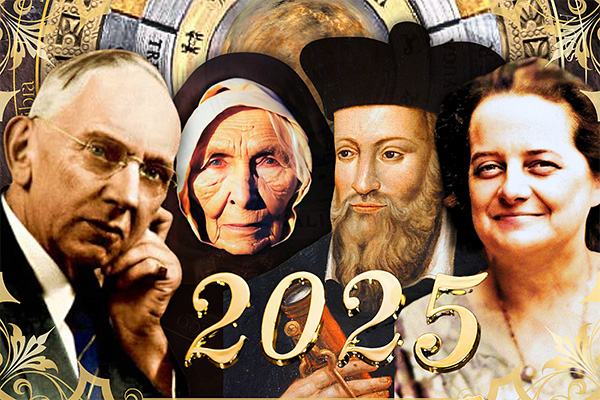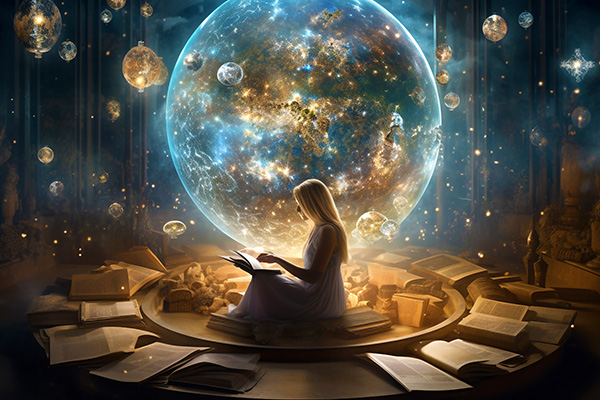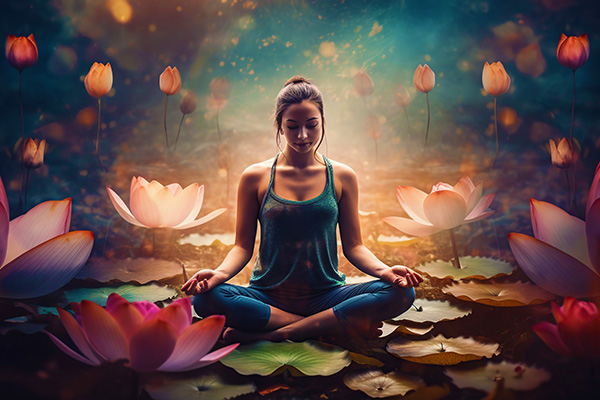hinduism
Abundance Rituals For A Prosperous 2025
 The universal energy of renewal and infinite possibility beckons as we enter the year 2025. The beginning of a new year is a great time to release old energies that no longer serve us and to invite a new wave of abundance, prosperity and fulfillment into our lives.
The universal energy of renewal and infinite possibility beckons as we enter the year 2025. The beginning of a new year is a great time to release old energies that no longer serve us and to invite a new wave of abundance, prosperity and fulfillment into our lives.
New Year’s manifestation practices not only clarify and align our intentions from the start, but also release energetic blockages, allowing prosperity and well-being to flourish. Releasing the old creates space for new possibilities and opportunities to flow into our lives.
The modern idea of setting intentions or “New Year’s resolutions” has its roots in various traditions. For centuries, cultures around the world have marked the transition to a new year with spiritual, esoteric, and religious practices and ceremonies.
In Mesopotamia, for example, the Akitu festival celebrated the Spring Equinox as the beginning of a new year and included rituals to honor the gods and ensure a bountiful harvest.
In Babylonia, at the beginning of each year, people made promises to their deities to return borrowed items and pay their debts. These promises were a way to start the year fresh and in good standing with the higher realms.
The ancient Romans perpetuated the tradition by dedicating the month of January to Janus, the two-faced god who looked both backward and forward to symbolize “looking back” on the past year and “looking forward” to the New Year, making it a time for personal reflection and new beginnings.
2025: Psychic Insights For The New Year
 As the final hours of 2024 tick away, the Psychic Access team reflects on the incredible journey we’ve shared with you this past year. To all of our valued clients and supporters, this message comes with heartfelt gratitude and warm wishes as we prepare to enter a new year together.
As the final hours of 2024 tick away, the Psychic Access team reflects on the incredible journey we’ve shared with you this past year. To all of our valued clients and supporters, this message comes with heartfelt gratitude and warm wishes as we prepare to enter a new year together.
The transition into a new year is always a powerful time. It’s a chance to pause and reflect on the lessons we’ve learned and the mistakes we’ve made. Every experience, whether joyful or painful, contains the seeds of wisdom. What did 2024 teach you about yourself? These reflections are not meant to create guilt, but to illuminate the path forward.
The year 2024 was filled with moments of incredible triumph, healing, and self-discovery for many of you, and it has been an honor to be with you every step of the way.
This past year also brought its share of karmic lessons and the overcoming of major setbacks and obstacles. For many, it was a year of intense growth through trial and tribulation — whether in relationships, career, health, finances, or spiritual awakening.
You turned to us for clarity in times of uncertainty, for connection with your guides, angels, ancestors and loved ones, and for divine guidance and spiritual insight to light your path.
Each interaction with you was a sacred exchange, an honor and a privilege, a moment when your courage and openness allowed us to support you in growth, healing and transformation.
The Spiritual Implications Of The Lazarus Syndrome
 Recently, while watching the 2008 film The Lazarus Project, I was reminded of the paranormal phenomenon of near-death experiences (NDEs) and became intrigued by the possibility of someone coming back to life after death.
Recently, while watching the 2008 film The Lazarus Project, I was reminded of the paranormal phenomenon of near-death experiences (NDEs) and became intrigued by the possibility of someone coming back to life after death.
The plot of the movie is about a man who is given a second chance at life after being executed for a crime. Despite being lethally injected, he somehow wakes up in a psychiatric hospital and must overcome a series of mysterious and mystical challenges to be reunited with his family.
The title, of course, refers to the story in John 11 of a man named Lazarus who was raised from the dead by Jesus after four days. While the plot of the movie does not directly parallel the biblical story, it does draw on the themes of resurrection and second chances.
My newfound curiosity soon led me to discover a documented medical phenomenon known as “Lazarus Syndrome.” Also known as the “Lazarus phenomenon” or “autoresuscitation,” it is a rare medical condition in which a person spontaneously comes back to life after all attempts at resuscitation have failed and the person has been pronounced dead.
The phenomenon was first noted in medical literature in 1982 by Finnish anesthesiologist Dr. Kalevi Linko, who described it as the spontaneous return of circulation after resuscitation efforts have ceased. The term “Lazarus phenomenon” was later popularized by Dr. John Francis Bray in 1993, who used the biblical reference to describe these rare cases of patients who spontaneously return to life.
Start Living Your Best Life, Today!
 Many years ago, my work took me to the lavishly decorated penthouse of a client who was a retired physician. I remember being in awe of the magnificent collection of books that lined the walls of his home.
Many years ago, my work took me to the lavishly decorated penthouse of a client who was a retired physician. I remember being in awe of the magnificent collection of books that lined the walls of his home.
“Your book collection is truly amazing,” I remember saying as I entered his beautiful home.
“Well, I worked very hard all my life, and one of my little pleasures outside of work was to buy all the books I felt inspired to read. Unfortunately, because I was always so busy and worked very long hours, I had put off reading most of them. But I constantly reminded myself that one day, when I retire, I would read all these wonderful books,” he said. “Unfortunately, it is too late for that now.”
It was too late…because he had tragically gone blind from an illness.
I will never forget that heartbreaking moment, standing in that lovely room lined with some of the most wonderful works of literature ever published. To this day, it reminds me of the importance of doing the things that bring us joy while we can.
The moral of the story is that although the blind doctor did wonderful things for his patients and the medical profession, he didn’t take much time for his own joy and fulfillment in the present moment.
This is why we need to live our lives in the now! Too often we put off our passions because we think there’s always time. But living fully in the present allows us to appreciate each moment, which fuels joy and fulfillment.
Transform Your Life With Akashic Healing
 Exploring my own Akashic record was a profoundly healing and enlightening experience. By accessing this information, I was able to uncover deep-rooted karmic patterns that spanned across lifetimes. Discovering the origins of these patterns helped me understand why certain fears and emotional blockages existed in my present life.
Exploring my own Akashic record was a profoundly healing and enlightening experience. By accessing this information, I was able to uncover deep-rooted karmic patterns that spanned across lifetimes. Discovering the origins of these patterns helped me understand why certain fears and emotional blockages existed in my present life.
For example, one major discovery I made was the origin of a lingering fear of abandonment and persecution that I could not attribute to anything that had happened in my current lifetime.
By delving into my Akashic record, I uncovered past life memories of being persecuted as a witch and burned alive at the stake, which had left an indelible imprint on my soul memory. Although this discovery was painful, it gave me the clarity I needed to heal those karmic wounds.
The Akashic Records are a metaphysical “library” or energetic “database” that contains all the information about our soul’s journey across lifetimes. The Akasha holds records of every thought, action, emotion and experience our soul has ever had. It is part of the collective consciousness or universal memory that transcends time and space, and by tapping into this archived metaphysical information, one can gain insight into one’s past lives, current life situations, and potential future paths.
The term “Akasha” comes from the Sanskrit word for “ether” or “sky” and refers to the source energy or creative life force that permeates the entire universe. In Hinduism and Buddhism, Akasha is traditionally seen as the primary substance from which all things are formed and is considered the fifth element, along with earth, water, fire, and air.
The Spiritual Wisdom Of Letting Go
 I sometimes do readings for clients who feel they have to control absolutely everything in their lives. They are rarely calm, rarely happy, always frazzled. There’s a constant tension around them, a palpable anxiety, as if they’re always one step away from a meltdown, or even a complete breakdown.
I sometimes do readings for clients who feel they have to control absolutely everything in their lives. They are rarely calm, rarely happy, always frazzled. There’s a constant tension around them, a palpable anxiety, as if they’re always one step away from a meltdown, or even a complete breakdown.
Many of us have experienced this feeling or seen it in others – the compulsion to control every outcome, every detail, believing that by sheer force of will we can make life bend to our wishes.
But here’s the thing: life has a way of moving on its own, whether we like it or not. And often, the more we try to grasp and hold on, the more things slip out of our control.
A song that often comes to mind when I think about this is the song Let It Be by the Beatles. Let it be, let it be. There will be an answer, let it be. This timeless classic is a simple yet powerful reminder of the peace that can come from stopping to resist and simply allowing things to unfold as they are meant to.
Letting go is not about giving up; it’s about trusting that life has a rhythm, a universal flow, and when we align ourselves with it, life becomes infinitely more peaceful and enjoyable.
In my work as a psychic consultant, I’ve found that those who feel the need to control every aspect of their lives often carry a heavy burden of stress. They struggle to find joy because they are too preoccupied with micromanaging every little detail. Life becomes a series of hurdles and challenges, and instead of going with the flow, they are constantly swimming against the current. It’s exhausting and soul-destroying.
Healing Your Chakras With Flower Power
 Plants have long been regarded as nature’s healers, offering remedies for a wide range of physical ailments. But beyond their traditional medicinal uses, plants — especially flowers — have incredible energetic properties that can profoundly affect our well-being.
Plants have long been regarded as nature’s healers, offering remedies for a wide range of physical ailments. But beyond their traditional medicinal uses, plants — especially flowers — have incredible energetic properties that can profoundly affect our well-being.
As a firm believer in the healing power of plants. I have seen firsthand how Mother Nature can work in harmony with our body, mind and spirit.
Flowers in particular, with their delicate beauty, aromatic essential oils and subtle vibrational frequencies, have powerful healing properties.
It is no coincidence that flowers are used in many cultural traditions to convey empathy and caring, to provide comfort, and to promote well-being. This is not simply because flowers are pretty and colorful, but because they have such powerful healing properties.
In many cultures, flowers are used to express sympathy and support. For example, it is common to send a bouquet of “get well soon” flowers to someone who is ill or recovering from surgery. Flowers such as lilies and daisies are often chosen for their associations with purity and cheerfulness, helping to lift the recipient’s spirits and contribute to emotional healing.
In Japan the practice of giving flowers, known as hanakotoba (flower language), is deeply embedded in cultural rituals. Each flower has a specific meaning, and their use conveys messages of sympathy, respect or congratulations. Chrysanthemums are associated with long life and are often given to the sick or elderly to wish them good health and longevity. The thoughtful selection of flowers is believed to bring emotional healing and comfort. Continue reading